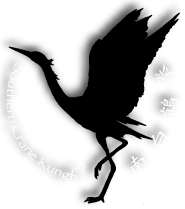About our Crane Boxing
The folk history of Fujian Calling Crane Boxing
Fujian Calling Crane principles: Based on the strength, elegance, fluidity and striking speed of the Chinese Red Crowned Crane. To strike and defend with precision, deflect and manipulate. To use softness, speed and power to attack and control the opponent.
It is widely accepted that Fujian White Crane kungfu was created by a female kungfu Master called Fang QiNiang roughly three hundred years ago in the province of Fujian, which is famous for its crane styles today. However, as with all great legends, the truth of who, when and where can never truly be known.
As time passed by however, White Crane evolved into four distinct styles that are still prominent today in Fuzhou, which is the capital of Fujian Province, and across the entire county. Those styles are: Flying White Crane; Eating White Crane; Calling White Crane; and Shaking White Crane. A further, lesser seen style is Sleeping White Crane. White Crane for Fujian Province is the ancestor of Chinese Wing Chun kungfu, as well as Japanese Okinawan karate.
Southern Crane Kungfu’s Chief and Head Instructors as well as select students train today in Fuzhou with our Calling Crane Master, and in the past we have also trained with a Shaking White Crane Master.
Calling White Crane in Fuzhou was mainly taught by Grandmaster Xie ZongXiang (1852 – 1930) who was also known as Xie RuRu in the local dialect. Due to his fast and clever leg techniques, Grandmaster Xie ZongXiang won himself the nickname of ‘Speeding Leg RuRu’.
The Calling White Crane style taught by Grandmaster Xie ZongXiang attached great importance to breathing techniques, and the combined use of mind and energy as well as qi, which translates in many ways to include ‘breath’, ‘life force’ and ‘flow of energy’, as well as the calling or whooping sounds of the crane (the style is often also called Whooping White Crane).
The root of the style lies in San Zhan, which is widely known as Three Wars. The Three Wars requires the balance of the hands, eyes, body and stance and also demands the integrity of the internal and external aspects of mind, energy and qi.
For every practitioner entering into the realm of Calling White Crane the Three Wars is the simple yet fundamental pattern they will keep practicing for the entirety of their life. In Fuzhou, a white crane saying goes that kungfu starts from the Three Wars, and the Three Wars accompanies one to the tomb.
Master Chen ShiDing (1898 – 1976), nicknamed MaHuo, was the most favoured disciple of Grandmaster Xie ZongXiang. Master Chen ShiDing trained under Grandmaster Xie ZongXiang for years and later served as his assistant instructor.
Like his kungfu brothers, Master Chen ShiDing taught all the traditional patterns of Calling White Crane, however, he also invented a pattern called HuBaBu. Based on BaBuLian, Master Chen ShiDing created this new pattern to help practitioners successfully rid themselves of stiffness of movements, thus promising a smooth flow of internal energy.
One of Master Chen ShiDing’s key students was Master Ruan Dong, who was passed the essence of the style by Master Chen ShiDing towards the end of his life. Master Ruan Dong also left his stamp on the style with his distinctive ability to move as a crane, and he taught Master Feng Wu, who today teachers us at Southern Crane Kungfu.
